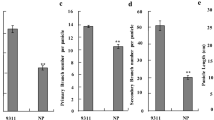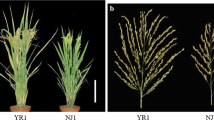Abstract
Near isogenic lines (NILs) can be used to efficiently handle a target quantitative trait locus (QTL) by blocking genetic background noise. One QTL, SPP1, which controls the number of spikelets per panicle (SPP), was located on chromosome 1, near Gn1a, a cloned gene for rice production in a recombinant inbred line population. NILs of the SPP1 regions were quickly obtained by self-crossing recombinant inbred line 30 which is heterozygous around SPP1. Using a random NIL-F2 population of 210 individuals, we mapped SPP1 to a 2.2-cM interval between RM1195 and RM490, which explained 51.1% of SPP variation. The difference in SPP between the two homozygotes was 44. F2-1456, one NIL-F2 plant, was heterozygous in the SPP1 region but was fixed in the region of Gn1a gene. This plant F3 family showed a very wide variation in SPP, which suggested that it was SPP1 but Gn1a affected the variation of SPP in this population. In a word, SPP1 is a novel gene distinct from Gn1a. Four newly developed InDel markers were used for high-resolution mapping of SPP1 with a large NIL-F2 population. Finally, it was narrowed down to a bacterial artificial chromosome clone spanning 107 kb; 17 open reading frames have been identified in the region. Of them, LOC_Os01g12160, which encodes an IAA synthetase, is the most interesting candidate gene.


Similar content being viewed by others

References
Aloni R, Aloni E, Langhans M, Ullrich CI (2006) Role of auxin in regulating Arabidopsis flower development. Planta 223:315–328
Ashikari M, Sakakibara H, Lin S, Yamamoto T, Takashi T, Nishimura A, Angeles ER, Qian Q, Kitano H, Matsuoka M (2005) Cytokinin oxidase regulates rice grain production. Science 309:741–745
Brummell DA, Hall B, Bennett AB (1999) Antisense suppression of tomato endo-1, 4-beta glucanase Cel2 mRNA accumulation increases the force required to break fruit abscission zones but does not affect fruit softening. Plant Mol Biol 40:615–622
Cammue B, Thevissen K, Hendriks M, Kristel Eggermont K, Goderis I, Proost P, Damme J, Osborn R, Guerbette F, Kader J, Broekaert W (1995) A potent antimicrobial protein from onion seeds showing sequence homology to plant lipid transfer proteins. Plant Physiol 109:445–455
Chu Z, Yuan M, Yao J, Ge X, Yuan B, Xu C, Li X, Fu B, Li Z, Bennetzen JL, Zhang Q, Wang S (2006) Promoter mutations of an essential gene for pollen development result in disease resistance in rice. Genes Dev 20:1250–1255
Dansen T, Westerman J, Wouters F, Wanders R, Hoek A, Gadella T, Wirtz K (1999) High-affinity binding of very-long-chain fatty acyl-CoA esters to the peroxisomal non-specific lipid-transfer protein (sterol carrier protein22). Biochem J 339:193–199
Fan CC, Xing YZ, Mao HL, Lu TT, Han B, Xu CG, Li XH, Zhang QF (2006) GS3, a major QTL for grain length and weight and minor QTL for grain width and thickness in rice, encodes a putative transmembrane protein. Theor Appl Genet 112:1164–1171
Flors V, Leyva M, Vicedo B, Finiti I, Real M, García-Agustín P, Bennett B, González-Bosch C (2007) Absence of the endo-b-1, 4-glucanases Cel1 and Cel2 reduces susceptibility to Botrytis cinerea in tomato. Plant J 52:1027–1040
Gamas P, Niebel FC, Lescure N, Cullimore JV (1996) Use of a subtractive approach to identify new Medicago truncatula genes induced during root nodule development. Mol Plant Microbe Interact 9:233–242
Gaudet D, Laroche A, Frick M, Huel R, Puchalski B (2003) Cold induced expression of plant defensin and lipid transfer protein transcripts in winter wheat. Physiol Plantarum 117:1399–3054
Goto N, Katoh N, Kranz AR (1991) Morphogenesis of floral organs in Arabidopsis: predominant carpel formation of the pin-formed mutant. Jpn J Genet 66:551–567
Guan CM, Zhu SS, Li XG, Zhang XS (2006) Hormone-regulated inflorescence induction and TFL1 expression in Arabidopsis callus in vitro. Plant Cell Rep 25:1133–1137
Hittalmani S, Huang N, Courtois B, Venuprasad R, Shashidhar HE, Zhuang JY, Zheng KL, Liu GF, Wang GC, Sidhu JS, Srivantaneeyakul S, Singh VP, Bagali PG, Prasanna HC, McLaren G, Khush GS (2003) Identification of QTL for growth- and grain yield-related traits in rice across nine locations of Asia. Theor Appl Genet 107:679–690
Ishimaru K, Ono K, Kashiwagi T (2004) Identification of a new gene controlling plant height in rice using the candidate-gene strategy. Planta 218:388–395
Kobayashi M, Sakurai A, Saka H, Takahashi N (1989) Fluctuation of the endogenous IAA level in rice during its life cycle. Agric Biol Chem 53:1089–1094
Lander ES, Botstein D (1989) Mapping Mendelian factors underlying quantitative traits using RFLP linkage maps. Genetics 121:185–199
Lashbrook CC, González-Bosch C, Bennett AB (1994) Two divergent endo-beta-1, 4-glucanase genes exhibit overlapping expression in ripening fruit and abscising flowers. Plant Cell 6:1485–1493
Li Z, Pinson SRM, Park WD, Paterson AH, Stansel JW (1997) Epistasis for three grain yield components in rice (Oryza sativa L.). Genetics 145:453–465
Li JM, Thomson M, McCouch RS (2004) Fine mapping of a grain weight quantitative trait locus in the pericentromeric region of rice chromosome 3. Genetics 168:2187–2195
Lincoln S, Daley M, Lander E (1992) Constructing genetic maps with MAPMAKER/EXP 3.0. In: Whitehead Institute technical report, 3rd edn. Whitehead Institute, Cambridge
Lincoln SE, Daly MJ, Lander ES (1993) Mapping genes controlling quantitative traits with MAPMAKER/QTL1.1: a tutorial and reference manual, 2nd edn. Whitehead Institute, Cambridge
McCouch SR, Teytelman L, Xu Y, Lobos KB, Clare K, Walton M, Fu B, Maghirang R, Li Z, Xing Y, Zhang Q, Kono I, Yano M, Fjellstrom R, DeClerck G, Schneider D, Cartinhour S, Ware D, Stein L (2002) Development and mapping of 2, 240 new SSR markers for rice (Oryza sativa L.). DNA Res 9:199–207
Monna L, Lin X, Kojima S, Sasaki T, Yano M (2002a) Genetic dissection of a genomic region for a quantitative trait locus, Hd3, into two loci, Hd3a and Hd3b, controlling heading date in rice. Theor Appl Genet 104:772–778
Monna L, Kitazawa N, Yoshino R, Suzuki J, Masuda H, Maehara Y, Tanji M, Sato M, Nasu S, Minobe Y (2002b) Positional cloning of rice semidwarfing gene, sd-1: rice “green revolution gene” encodes a mutant enzyme involved in gibberellin synthesis. DNA Res 9:11–17
Murray MG, Thompson WF (1980) Rapid isolation of high molecular weight plant DNA. Nucleic Acids Res 8:4321
Oka M, Miyamoto K, Okada K, Ueda J (1999) Auxin polar transport and flower formation in Arabidopsis thaliana transformed with indoleacetamide hydrolase (iaaH) gene. Plant Cell Physiol 40:231–237
Okada K, Shimura Y (1994) Genetic analyses of signalling in flower development using Arabidopsis. Plant Mol Biol 26:1357–1377
Okada K, Ueda J, Komaki MK, Bell CJ, Shimura Y (1991) Requirement of the auxin polar transport system in early stages of Arabidopsis floral bud formation. Plant Cell 3:677–684
Ren ZH, Gao JP, Li LG, Cai XL, Huang W, Chao DY, Zhu MZ, Wang ZY, Luan S, Lin HX (2005) A rice quantitative trait locus for salt tolerance encodes a sodium transporter. Nat Genet 37:1141–1146
Septiningsih EM, Prasetiyono J, Lubis E, Tai TH, Tjubaryat T, Moeljopawiro S, McCouch SR (2003) Identification of quantitative trait loci for yield and yield components in an advanced backcross population derived from the Oryza sativa variety IR64 and the wild relative O. rufipogon. Theor Appl Genet 107:1419–1432
Song XJ, Huang W, Shi M, Zhu MZ, Lin HX (2007) A QTL for rice grain width and weight encodes a previously unknown RING-type E3 ubiquitin ligase. Nat Genet 39:623–630
Sun X, Cao Y, Yang Z, Xu C, Li X, Wang S, Zhang Q (2004) Xa26, a gene conferring resistance to Xanthomonas oryzae pv. oryzae in rice, encodes an LRR receptor kinase-like protein. Plant J 37:517–527
Temnykh S, Park WD, Ayres N, Cartihour S, Hauck N, Lipovich L, Cho YG, Ishii T, McCouch SR (2000) Mapping and genome organization of microsatellite sequences in rice (Oryza sativa L.). Theor Appl Genet 100:697–712
Temnykh S, Declerck G, Luashova A, Lipovich L, Cartinhour S, McCouch S (2001) Computational and experimental analysis of microsatellites in rice (Oryza sativa L.): frequency, length variation, transposon associations, and genetic marker potential. Genome Res 11:1441–1452
Tian F, Zhu Z, Zhang B, Tan L, Fu Y, Wang X, Sun CQ (2006) Fine mapping of a quantitative trait locus for grain number per panicle from wild rice (Oryza ruffipogon Griff.). Theor Appl Genet 113:619–629
Tuinstra MR, Ejeta G, Goldsbrough PB (1997) Heterogeneous inbred family (HIF) analysis: a method for developing near-isogenic lines that differ at quantitative trait loci. Theor Appl Genet 95:1005–1011
Wu KS, Tanksley SD (1993) Abundance, polymorphism and genetic mapping of microsatellites in rice. Mol Gen Genet 241:225–235
Wu G, Robertson AJ, Liu X, Zheng P, Wilen RW, Nesbitt NT, Gusta LV (2004) A lipid transfer protein gene BG-14 is differentially regulated by abiotic stress, ABA, anisomycin, and sphingosine in bromegrass (Bromus inermis). Plant Physiol 161:449–458
Xing YZ, Tan YF, Hua JP, Sun XL, Xu CG, Zhang Q (2002) Characterization of the main effects, epistatic effects and their environmental interactions of QTLs on the genetic basis of yield traits in rice. Theor Appl Genet 105:248–257
Xing YZ, Tang WJ, Xue WY, Xu CG, Zhang Q (2008) Fine mapping of a major quantitative trait loci, qSSP7, controlling the number of spikelets per panicle as a single Mendelian factor in rice. Theor Appl Genet 116:789–796
Xue W, Xing Y, Weng X, Zhao Y, Tang W, Wang L, Zhou H, Yu S, Xu C, Li X, Zhang Q (2008) Natural variation in Ghd7 is an important regulator of heading date and yield potential in rice. Nat Genet 40(6):761–767
Yamamoto T, Kuboki Y, Lin SY, Sasaki T, Yano M (1998) Fine mapping of quantitative trait loci Hd-1, Hd-2 and Hd-3, controlling heading date of rice, as single Mendelian factors. Theor Appl Genet 97:37–44
Yamamoto T, Lin HX, Sasaki T, Yano M (2000) Identification of heading date quantitative trait locus Hd6 and characterization of its epistatic interactions with Hd2 in rice using advanced backcross progeny. Genetics 154:885–891
Yang Z, Sun X, Wang S, Zhang Q (2003) Genetic and physical mapping of a new gene for bacterial blight resistance in rice. Theor Appl Genet 106(8):1467–1472
Yu SB, Li JX, Xu CG, Tan YF, Gao YJ, Li XH, Zhang QF (1997) Importance of epistasis as the genetic basis of heterosis in an elite rice hybrid. Proc Natl Acad Sci USA 94:9226–9231
Zhang YS, Luo LJ, Xu CG, Zhang QF, Xing YZ (2006) Quantitative trait loci for panicle size, heading date and plant height co-segregating in trait-performance derived near-isogenic lines of rice (Oryza sativa). Theor Appl Genet 113:361–368
Zhuang JY, Lin HX, Lu J, Qian HR, Hittalmani S, Huang N, Zheng KL (1997) Analysis of QTL × environment interaction for yield components and plant height in rice. Theor Appl Genet 95:799–808
Zhuang JY, Fan YY, Rao ZM, Wu JL, Xia YW, Zheng KL (2002) Analysis on additive effects and additive-by-additive epistatic effects of QTLs for yield traits in a recombinant inbred line population of rice. Theor Appl Genet 105:1137–1145
Acknowledgments
This work was supported by a grant from the National Key Program on Basic Research and Development of China, a grant from National Natural Science Foundation of China, and a grant for New Century Excellent Talents from the Education Ministry of China.
Author information
Authors and Affiliations
Corresponding author
Additional information
Communicated by H. H. Geiger.
Rights and permissions
About this article
Cite this article
Liu, T., Mao, D., Zhang, S. et al. Fine mapping SPP1, a QTL controlling the number of spikelets per panicle, to a BAC clone in rice (Oryza sativa). Theor Appl Genet 118, 1509–1517 (2009). https://doi.org/10.1007/s00122-009-0999-0
Received:
Accepted:
Published:
Issue Date:
DOI: https://doi.org/10.1007/s00122-009-0999-0



